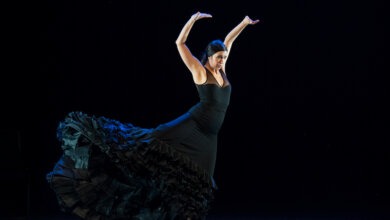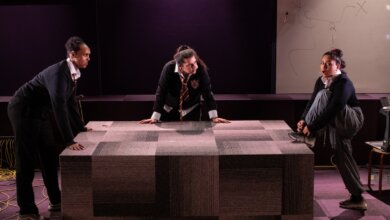Writer: William Shakespeare
Director: Juliet Forster
Reviewer: Jim Gillespie
The Globe Theatre, on London’s South Bank, has given theatre-goers a real feel for the experience of theatre in Shakespeare’s own time. Open to the elements, and the noises-off from a busy city, intimate and involving, with little of the technical wizardry available in a modern theatre setting.
The London Rose Playhouse was built 12 years before the Globe, along similar lines, and has inspired the creation of Europe’s first ever pop-up Shakespearean theatre. An anachronism in both its modernity and its Elizabethanism, it stands beneath the medieval remains of Clifford’s Tower in a car park in York. Looking not altogether unlike a half-timbered overweight rocket-ship, it is an ingenious edifice of scaffolding, timber and metal decking.
Throughout the summer of 2018, four of Shakespeare’s most popular plays grace this unique space, performed by two companies in repertory. The inclusion of A Midsummer Night’s Dreammust have been one of the easiest decisions. It is among the most accessible plays in the Shakespeare canon, perennially popular, light and frothy, it ideally suits an external performance in the most glorious summer in memory.
In a wood outside Athens, two pairs of mismatched lovers, two groups of warring fairies, led by their combative monarchs, together with a ramshackle troupe of amateur actors, provide a three-ring circus of comic confusion, magical mayhem, and general buffoonery, before all ends happily ever after for all parties.
The bespoke theatre has obviously brought opportunities for creative exploitation of the traditional playing space of the Elizabethan theatre. So while we have balconies, trapdoors, and staircases that would have been familiar to Shakespeare’s contemporaries, we also have roof voids and hoists, opening up new aerial possibilities. These are fully utilised in a production blessed with an energetic, acrobatic cast, and a director for whom choreography includes rope-climbing, ribbon spinning, and gymnastics.
The fairies, in particular, own this space. They slide down drapes, climb over the structure, balance on the ropes, swing around the set, and generally monkey around. They are half satyrs, half chimpanzees; earthy in tone, sylvan creatures, athletic, mischievous, threatening. Rather than being fey, these are creatures of the darkness and the night. Both Oberon and Titania (played cross-gendered by Amanda Ryan and Anthony Bunsee) are tough-minded rulers of magical but mighty kingdoms, not effete sprites. The fairies are a silent, watching presence on the stage throughout, as the humans play out their convoluted romances. Clare Corbett’s Puck is less the leader of this band than the involved outsider; more powerful, but more independent of spirit than the subservient fairy retinues.
The humans have less interesting space to inhabit. Terra firma is a confusing space when overlaid with magical interference from the fairy kingdom. Olivia Oneyehara and Mark Holgate do their best to make sense of it all as the decent, if strait-laced, Helena and Demetrius. Understudy Niall Costegan took on the role of Lysander on press night, giving a fluent performance, while Amy Lennox stole almost every scene as a pugnacious, passionate Hermia.
Also on Terra Firma is the artisan theatre troupe rehearsing their nuptial entertainment away from prying eyes in the forest outside Athens. Ostensibly led by Peter Quince, ably played by Rina Mahoney, the most forceful personality in the am-dram group is unquestionably Bottom, the Weaver. Paul Hawkyard gives the role its full rein, and then some, in an earthy, warm-hearted portrayal of this larger-than-life character. Nothing in his performance is out of place. Not even his brutal addition of an orifice to the wall separating Pyramus and Thisbe; one of the funniest moments of the play.
The timber stage is as bare-boned as it could be. The fairies add a network of thick ropes to assist their acrobatics, and these are also employed imaginatively to create thickets, and to provide weapons for the feuding lovers. A flowered casket on wheels provides a lovers’ bower for Titania and Bottom, and Hermia is burdened with more baggage than she can master, as she evades and pursues potential lovers in the woods. This apart, the production uses little more than the skill of the actors, and the imagination of the audience, to augment the production.
The music is live and sometimes lively, providing a magical soundtrack to the show. Or would do, if it did not sometimes drown out the very speeches it is intended to enhance. When appropriate, it works well to augment the tension or the ethereal nature of a scene, and it hits a raucous highpoint with an ensemble cossack dance. There was a noticeable improvement in the incidental music when the percussion gave way to the cello.
The press preview was a daytime matinee, in full sun, and with none of the enchantment which an evening performance might add to the occasion, as stars come out, moonlight streams, and shadows disguise the everyday workings of the theatre. Nevertheless, this was a magical production, full of invention and energy, in a wonderful space.
Runs at Shakespeare’s Rose Theatre, York until 30 August 2018 | Image: Anthony Robling





